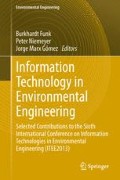Abstract
In environmental engineering, experts from different disciplines and with diverse backgrounds and responsibilities need to cooperate. As they tackle problems important to society and practice, this type of cooperation can be characterized as transdisciplinary. In transdisciplinary settings, the actors involved bring together theory, models and knowledge from different disciplines. In order to integrate this knowledge and to create a better understanding of the complex issues under consideration, experts can use methods like knowledge mapping. Compared to other methods used in environmental engineering, knowledge maps are based on a lower degree of formalization. In this article, we derive requirements for a method and a tool for supporting the interactive creation of knowledge maps in groups from theory and from existing methods related to environmental engineering. Based on these requirements, we describe the concept of a new method and a supporting tool called DialogueMaps. This tool is web-based and aims at supporting transdisciplinary interactive dialogues for developing multi-layer knowledge maps.
Access this chapter
Tax calculation will be finalised at checkout
Purchases are for personal use only
References
Kunz W, Rittel H (1970) Issues as elements of information systems. working paper no. 131, Studiengruppe für Systemforschung, Heidelberg, Germany, July 1970 (Reprinted May 1979)
Okada A, Shum S, Sherborne T (eds) (2008) Knowledge cartography: software tools and mapping techniques. Springer, London
Balsiger PW (2005) Transdisziplinarität. Wilhelm Fink, München
Gibbons M et al (1994) The new production of knowledge: the dynamic of science and research in contemporary societies. Sage, London
Wahoff J-H, Porto de albuquerque J, Rolf A (2012) The mikropolis model: a framework for transdisciplinary research of information systems in society. In: Dwivedi YK et al (eds) Information systems theory: explaining and predicting our digital society. Springer, New York, pp 367–386
Pohl C, Hirsch Hadorn G (2006) Gestaltungsprinzipien für die transdisziplinäre Forschung. Oekom, München
Möller A (2000) Grundlagen stoffstrombasierter betrieblicher Umweltinformationssysteme. Projekt, Bochum
Flusser V (1998) Kommunikologie. Fischer, Frankfurt
Hartmann F, Bauer EK (2006) Bildersprache, Otto Neurath, Visualisierungen. WUV, Wien
Eve M, Burke C (2010) Otto neurath: from hieroglyphics to isotype—a visual autobiography. Hypen, London
Pettauer R (2002) Otto neurath revisited. http://www.heise.de/tp/artikel/13/13678/1.html. Accessed 03 Feb 2013
Hartmann F (1997) Sprechende Zeichen. http://www.heise.de/tp/artikel/2/2168/1.html Accessed 03 Feb 2013
Sandner G (2008) Otto Neuraths ‘Demokratisierung des Wissens’. http://science.orf.at/science/news/151757. Accessed 03 Feb 2013
Neurath O, Haller R, Kinross R (1991) Gesammelte bildpädagogische Schriften. Hölder Pichler Tempsky, Wien
Hartmann F (2000) Medienphilosophie. WUV, Wien
Leinthaler R (2008) Otto Neuraths Bildsprache ISOTYPE: Kommunikationsdesign und Gesellschaftspolitik. Diplomarbeit Universität Wien, Wien
Reis R (2008) Visualisierungen von Zugängen zur Wissensgesellschaft. Universität Wien, Fakultät für Sozialwissenschaften, Magisterarbeit
Dilg-Gruschinski K, Frank S (2003) eLearning mit Wissenslandkarten. http://www.bibb.de/de/limpact12477.htm. Accessed 03 Feb 2012
Armani J, Botturi L, Rocci A (2002) Maps as learning tools: the SWISSLING solution. In: Proceedings of the ICNEE 2002, Lugano, 8–11 May 2002
Maisch J (2006) Wissensmanagement am Gymnasium: Anforderungen der Wissensgesellschaften. VS, Wiesbaden
Eppler M (2001) Making knowledge visible through intranet knowledge maps: concepts, elements, cases. In: Proceedings of the 34th Hawaii international conference on system sciences, Maui, Hawaii, 3–6 Jan 2001
Vester F (1991) Neuland des Denkens: Vom technokratischen zum kybernetischen Zeitalter. Deutsche Verlags Anstalt, Stuttgart
Vester F (2002) Die Kunst vernetzt zu denken. DTV, München
Vester F (1995) Crashtest Mobilität: Die Zukunft des Verkehrs. Wilhelm Heyne, München
Vester F (1983) Ballungsgebiete in der Krise: Vom Verstehen und Planen menschlicher Lebensräume. DTV, München
Malik F (2013a) Malik Sensitivitätsmodell http://www.malik-management.com/de/malik-fuer-organisationen/loesungen-und-methoden/malik-sensitivitaetsmodell. Accessed 03 Feb 2013
Vester F (2013) Sensitivity model prof. Vester. http://www.frederic-vester.de/uploads/InformationEnglishSM.pdf. Accessed 03 Feb 2013
Schwabe G, Krcmar H (1996) CSCW Werkzeuge. Wirtschaftsinformatik 38(2):209–224
Malik F (2013b) Malik operations room http://www.malik-management.com/pdfs/brosch-ren-flyer/malikoperationsroombroschuere.pdf. Accessed 03 Feb 2013
Baumgarten B (1996) Petri-Netze—Grundlagen und Anwendungen. Spektrum, Heidelberg
GaBi software (2013) GaBi. http://www.gabi-software.com/deutsch/index/. Accessed 03 Feb 2013
ifu Hamburg GmbH (2013) Umberto. http://www.umberto.de/de/demos-screenshots/. Accessed 03 Feb 2013
Möller A, Häuslein A, Rolf A (1997) Öko-Controlling im Handelsunternehmen—Ein Leitfaden für das Stoffstrommanagement. Springer, Berlin
Conklin J (2003) Dialog mapping: reflections on an industrial strength—case study. In: Kirschner P, Shum S, Carr C (eds) Visualizing argumentation: tools for collaborative and educational sense-making. Springer, London
Conklin J (2006) Dialogue mapping: building shared understanding of wicked problems. Wiley, Chichester
Compendium (2013) Compendium institute. http://compendium.open.ac.uk/institute/. Accessed 03 Feb 2013
SourceForge (2013) DialogueMaps. https://sourceforge.net/projects/dialoguemaps/?source=directory. Accessed 03 Feb 2013
Hevner A, March S, Park K (2004) Design science in information systems research. MIS Q 28(1):75–105
Arnowitz J, Arent M, Berger N (2007) Effective prototyping for software makers. Morgan Kaufmann, San Francisco
Cohn M (2009) Succeeding with agile: software development using scrum. Addison-Wesley Longman, Amsterdam
Haußmann M, Scholz H (2008) Visual facilitating and graphic recording. Neuland, Geesthacht
IPPC (2007) Climate change 2007: the physical science basis. http://www.ipcc.ch/publications_and_data/publications_ipcc_fourth_assessment_report_wg1_report_the_physical_science_basis.htm. Accessed 03 Feb 2013
Author information
Authors and Affiliations
Corresponding author
Editor information
Editors and Affiliations
Rights and permissions
Copyright information
© 2014 Springer-Verlag Berlin Heidelberg
About this chapter
Cite this chapter
Drews, P., Sagawe, A. (2014). DialogueMaps: Supporting Interactive Transdisciplinary Dialogues with a Web-Based Tool for Multi-layer Knowledge Maps. In: Funk, B., Niemeyer, P., Gómez, J. (eds) Information Technology in Environmental Engineering. Environmental Science and Engineering(). Springer, Berlin, Heidelberg. https://doi.org/10.1007/978-3-642-36011-4_4
Download citation
DOI: https://doi.org/10.1007/978-3-642-36011-4_4
Published:
Publisher Name: Springer, Berlin, Heidelberg
Print ISBN: 978-3-642-36010-7
Online ISBN: 978-3-642-36011-4
eBook Packages: Earth and Environmental ScienceEarth and Environmental Science (R0)

